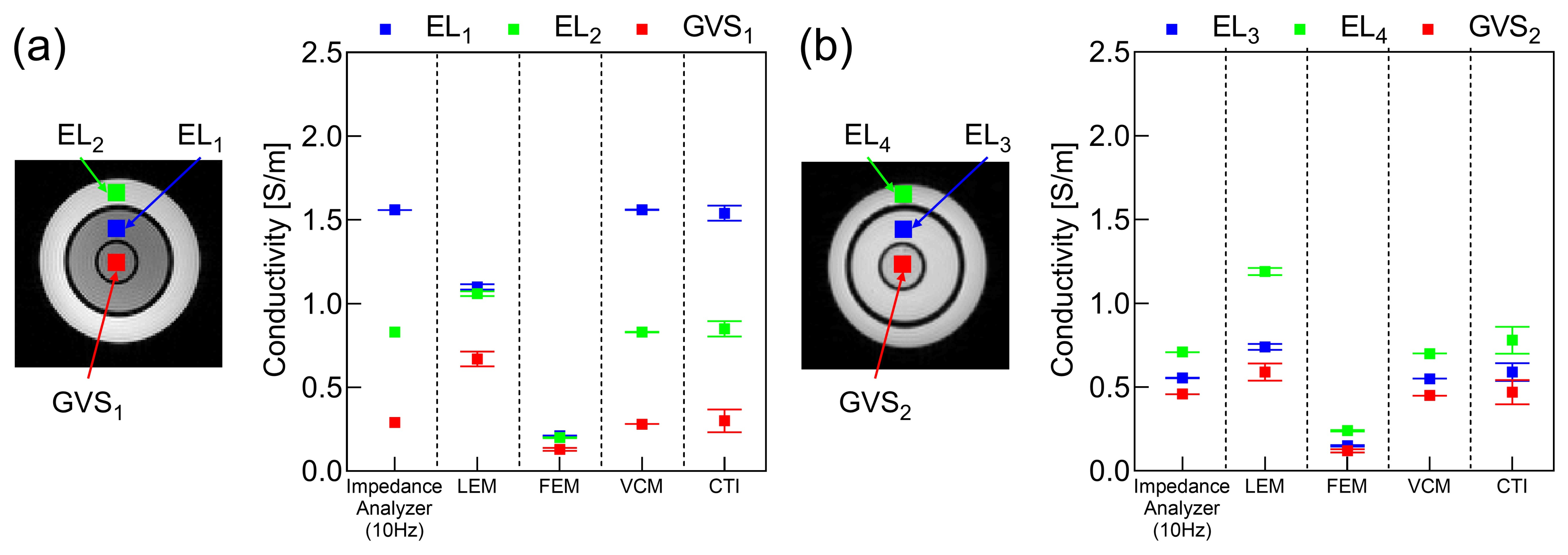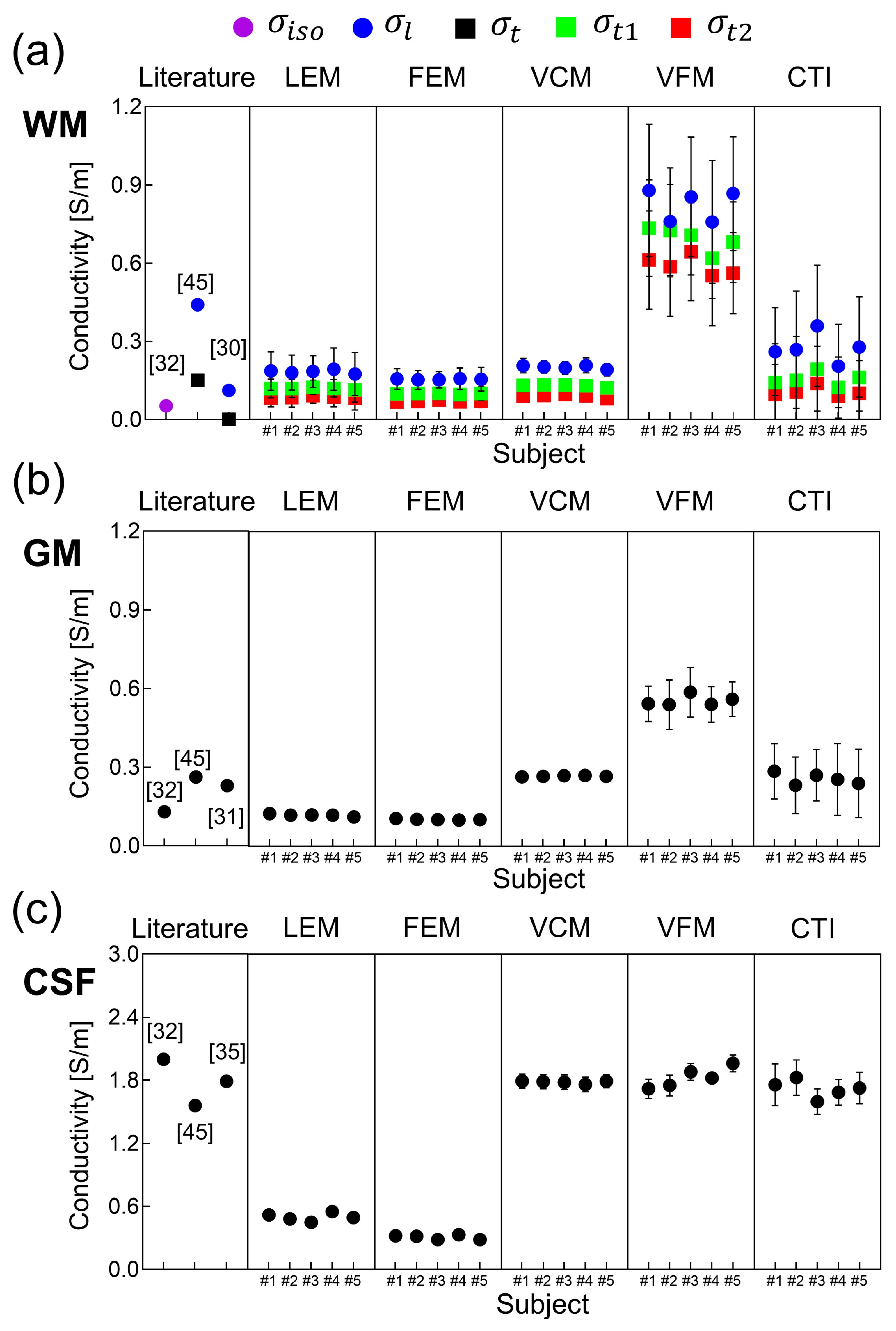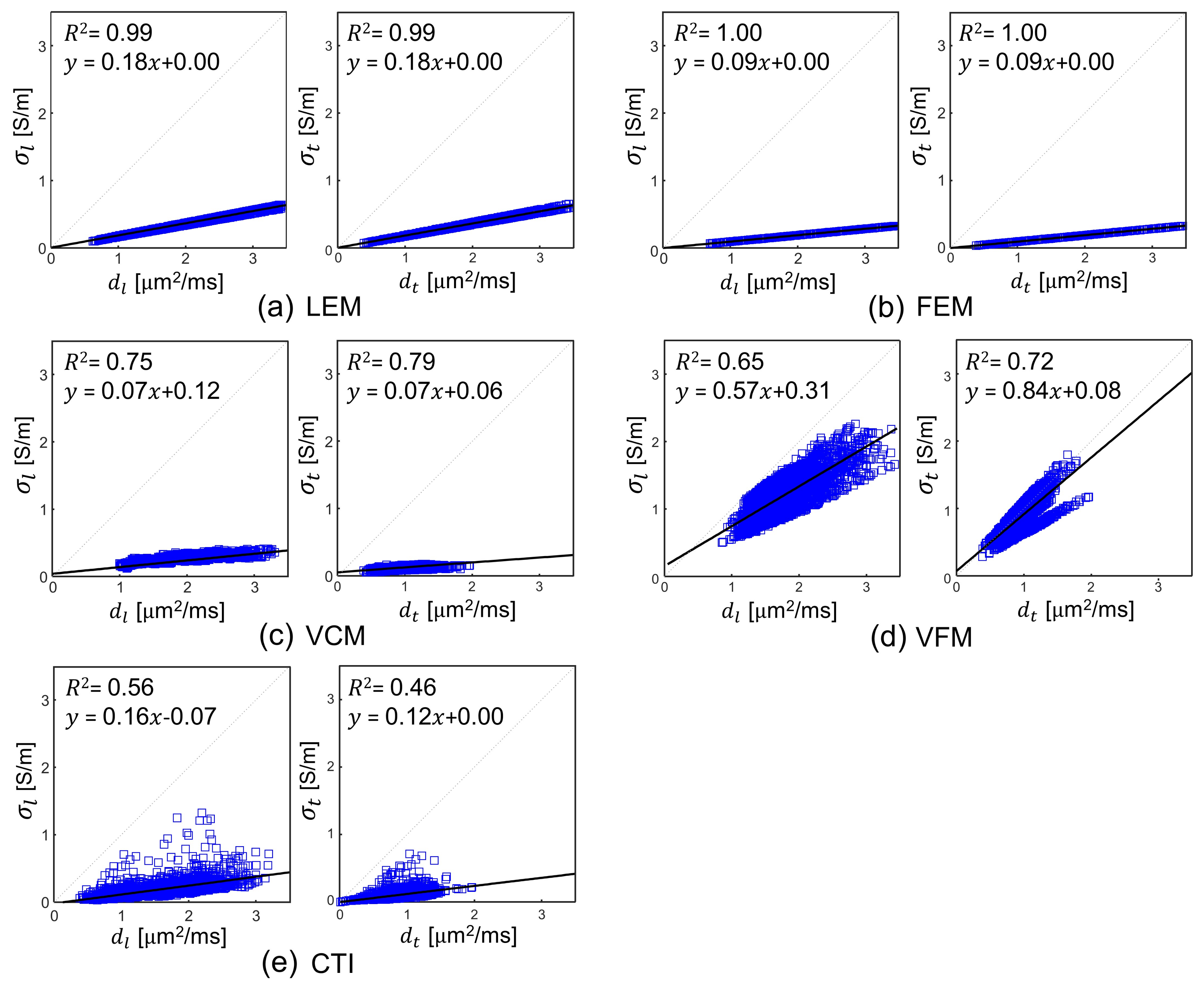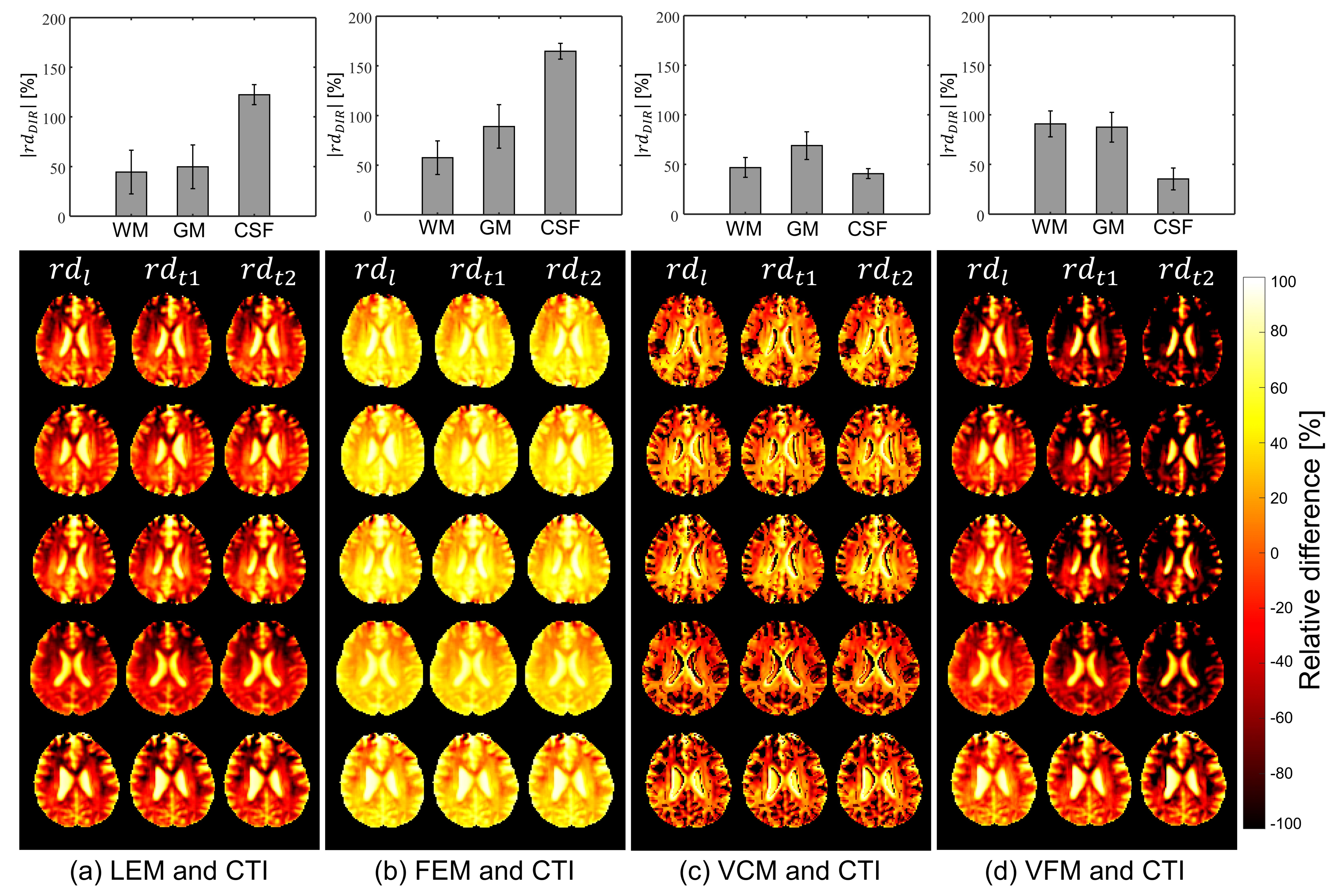Comparison of Five Conductivity Tensor Models and Image Reconstruction Methods Using MRI
Abstract
1. Introduction
2. Five Conductivity Tensor Models
2.1. Linear Eigenvalue Model (LEM)
2.2. Force Equilibrium Model (FEM)
2.3. Volume Constraint Model (VCM)
2.4. Volume Fraction Model (VFM)
2.5. Conductivity Tensor Imaging (CTI) Model
3. Imaging Experiments and Data Processing
3.1. Phantom Imaging
3.2. In Vivo Human Imaging
3.3. Data Processing
4. Results
4.1. Two Phantoms
4.2. Five Human Brains
5. Discussion
6. Conclusions
Author Contributions
Funding
Institutional Review Board Statement
Informed Consent Statement
Data Availability Statement
Acknowledgments
Conflicts of Interest
Abbreviations
| LEM | Linear Eigenvalue Model |
| FEM | Force Equilibrium Model |
| VCM | Volume Constraint Model |
| VFM | Volume Fraction Model |
| CTI | Conductivity Tensor Imaging |
| WM | White Matter |
| GM | Gray Matter |
| CSF | Cerebrospinal Fluid |
| MREPT | Magnetic Resonance Electrical Properties Tomography |
Appendix A
| Isotropic low-frequency conductivity (S/m) | |
| Longitudinal component of conductivity tensor (S/m) | |
| Transversal component of conductivity tensor (S/m) | |
| Longitudinal component of water diffusion tensor ( 2/) | |
| Transversal component of water diffusion tensor ( 2/) | |
| Isotropic low-frequency conductivity value from the literature (S/m) | |
| Isotropic extracellular diffusion coefficient ( 2/) | |
| Extracellular water diffusion tensor ( 2/) |
References
- Grimnes, S.; Martinsen, O.G. Bioimpedance and Bioelectricity Basics; Academic Press: London, UK, 2015. [Google Scholar]
- Kerner, E.H. The electrical conductivity of composite materials. Proc. Phys. Soc. B 1956, 69, 802–807. [Google Scholar] [CrossRef]
- Lux, F. Models proposed to explain the electrical conductivity of mixtures made of conductive and insulating materials. J. Mater. Sci. 1993, 28, 285–301. [Google Scholar] [CrossRef]
- Schwan, H.P. Electrical properties of tissue and cell suspensions. Adv. Biol. Med. Phys. 1957, 5, 147–209. [Google Scholar] [PubMed]
- Gabreil, C.; Peyman, A.; Grant, E.H. Electrical conductivity of tissue at frequency below 1 MHz. Phys. Med. Biol. 2009, 54, 4863–4878. [Google Scholar] [CrossRef] [PubMed]
- Choi, B.K.; Katoch, N.; Park, J.E.; Ko, I.O.; Kim, H.J.; Kwon, O.I.; Woo, E.J. Validation of conductivity tensor imaging using giant vesicle suspensions with different ion mobilities. Biomed. Eng. OnLine 2020, 19, 1–17. [Google Scholar] [CrossRef] [PubMed]
- Basser, P.J.; Mattiello, J.; Le bihan, D. MR diffusion tensor spectroscopy and imaging. Biophys. J. 1994, 66, 259–267. [Google Scholar] [CrossRef]
- Kwon, O.I.; Jeong, W.C.; Sajib, S.Z.K.; Kim, H.J.; Woo, E.J. Anisotropic conductivity tensor imaging in MREIT using directional diffusion rate of water molecules. Phys. Med. Biol. 2014, 59, 2955–2974. [Google Scholar] [CrossRef]
- Liu, J.; Yang, Y.; Katscher, U.; He, B. Electrical properties tomography based on B1 maps in MRI: Principles, applications, and challenges. IEEE Trans. Biomed. Eng. 2017, 64, 2515–2530. [Google Scholar] [CrossRef]
- Seo, J.K.; Woo, E.J. Magnetic resonance electrical impedance tomography (MREIT). SIAM Rev. 2011, 53, 40–68. [Google Scholar] [CrossRef]
- Seo, J.K.; Kim, D.H.; Lee, J.; Kwon, O.I.; Sajib, S.Z.K.; Woo, E.J. Electrical tissue property imaging using MRI at dc and Larmor frequency. Inv. Prob. 2012, 28, 084002. [Google Scholar] [CrossRef]
- Seo, J.K.; Woo, E.J. Electrical tissue property imaging at low frequency using MREIT. IEEE Trans. Biomed. Eng. 2014, 61, 1390–1399. [Google Scholar] [PubMed]
- Katscher, U.; Voigt, T.; Findeklee, C.; Vernickel, P.; Nehrke, K.; Dossel, O. Determination of electrical conductivity and local SAR via B1 mapping. IEEE Trans. Med. Imag. 2009, 28, 1365–1374. [Google Scholar] [CrossRef] [PubMed]
- Gurler, N.; Ider, Y.Z. Gradient-based electrical conductivity imaging using MR phase. Mag. Reson. Med. 2016, 77, 137–150. [Google Scholar] [CrossRef] [PubMed]
- Leijsen, R.; Brink, W.; van den Berg, C.; Webb, A.; Remis, R. Electrical properties tomography: A methodological review. Diagnostics 2021, 11, 176. [Google Scholar] [CrossRef] [PubMed]
- Sen, A.K.; Torquato, S. Effective conductivity of anisotropic two-phase composite media. Phys. Rev. B 1989, 39, 4504–4515. [Google Scholar] [CrossRef] [PubMed]
- Tuch, D.S.; Wedeen, V.J.; Dale, A.M.; George, J.S.; Belliveau, J.W. Conductivity tensor mapping of the human brain using diffusion tensor MRI. Proc. Nat. Acad. Sci. USA 2001, 98, 11697–11701. [Google Scholar] [CrossRef] [PubMed]
- Rullmann, M.; Anwander, A.; Dannhauer, M.; Warfield, S.K.; Duffy, F.H.; Wolters, C.H. EEG source analysis of epileptiform activity using a 1 mm anisotropic hexahedra finite element head model. NeuroImage 2009, 44, 399–410. [Google Scholar] [CrossRef]
- Sekino, M.; Yamaguchi, K.; Iriguchi, N.; Ueno, S. Conductivity tensor imaging of the brain using diffusion-weighted magnetic resonance imaging. J. App. Phys. 2003, 93, 6430–6732. [Google Scholar] [CrossRef]
- Sekino, M.; Inoue, Y.; Ueno, S. Magnetic resonance imaging of electrical conductivity in the human brain. IEEE Trans. Mag. 2005, 41, 4203–4205. [Google Scholar] [CrossRef]
- Miranda, P.C.; Pajevic, S.; Hallett, M.; Basser, P. The distribution of currents induced in the brain by magnetic stimulation: A finite element analysis incorporating DT-MRI-derived conductivity data. Proc. Int. Soc. Mag. Res. Med. 2001, 9, 1540. [Google Scholar]
- Wang, K.; Zhu, S.; Mueller, B.A.; Lim, K.O.; He, B. A new method to derive white matter conductivity from diffusion tensor MRI. IEEE Trans. Biomed. Eng. 2008, 55, 2481–2486. [Google Scholar] [CrossRef] [PubMed]
- Sajib, S.Z.K.; Kwon, O.I.; Kim, H.J.; Woo, E.J. Electrodeless conductivity tensor imaging (CTI) using MRI: Basic theory and animal experiments. Biomed. Eng. Lett. 2018, 8, 273–282. [Google Scholar] [CrossRef] [PubMed]
- Katoch, N.; Choi, B.K.; Sajib, S.Z.K.; Lee, E.; Kim, H.J.; Kwon, O.I.; Woo, E.J. Conductivity tensor imaging of in vivo human brain and experimental validation using giant vesicle suspension. IEEE Trans. Biomed. Eng. 2018, 38, 1569–1577. [Google Scholar] [CrossRef] [PubMed]
- Wu, Z.; Liu, Y.; Hong, M.; Yu, X. A review of anisotropic conductivity models of brain white matter based on diffusion tensor imaging. Med. Biol. Eng. Comput. 2018, 56, 1325–1332. [Google Scholar] [CrossRef] [PubMed]
- Wolters, C.H.; Anwander, A.; Tricoche, X.; Weinstein, D.; Koch, M.A.; Macleod, R.S. Influence of tissue conductivity anisotropy on eeg/meg field and return current computation in a realistic head model: A simulation and visualization study using high-resolution finite element modeling. NeuroImage 2006, 30, 813–826. [Google Scholar] [CrossRef]
- Vorwerk, J.; Aydin, Ü; Wolters, C.H.; Butson, C.R. Influence of head tissue conductivity uncertainties on EEG dipole reconstruction. Front. Neurosci. 2009, 13, 531. [Google Scholar]
- Shahid, S.; Wen, P.; Ahfock, T. Numerical investigation of white matter anisotropic conductivity in defining current distribution under tDCS. Comput. Meth. Prog. Biomed. 2013, 9, 48–64. [Google Scholar] [CrossRef]
- Lee, W.H.; Liu, Z.; Mueller, B.A.; Lim, K.O.; He, B. Influence of white matter anisotropic conductivity on EEG source localization: Comparison to fMRI in human primary visual cortex. Clin. Neurophysiol. 2009, 120, 2071–2081. [Google Scholar] [CrossRef]
- Nicholson, P.W. Specific impedance of cerebral white matter. Exp. Neurol. 1965, 13, 386–401. [Google Scholar] [CrossRef]
- Geddes, L.A.; Baker, L.E. The specific resistance of biological material: A compendium of data for the biomedical engineer and physiologist. Phys. Med. Biol. 1967, 44, 193–271. [Google Scholar] [CrossRef]
- Gabriel, C.; Gabriel, S.; Corthout, E. The dielectric properties of biological tissues: I. Literature survey. Phys. Med. Biol. 1996, 41, 2231–2249. [Google Scholar] [CrossRef]
- Niendorf, T.; Dijkhuizen, R.M.; Norris, D.G.; Campagne, M.V.K.; Nicolay, K. Biexponential diffusion attenuation in various states of brain tissue: Implications for diffusion-weighted imaging. Mag. Reson. Med. 1996, 36, 847–857. [Google Scholar] [CrossRef]
- Clark, C.A.; Hedehus, M.; Moseley, M.E. In vivo mapping of the fast and slow diffusion tensors in human brain. Mag. Reson. Med. 2002, 47, 623–628. [Google Scholar] [CrossRef]
- Baumann, S.B.; Wozny, D.R.; Kelly, S.K.; Meno, F.M. The electrical conductivity of human cerebrospinal fluid at body temperature. IEEE Trans. Biomed. Eng. 1997, 44, 220–223. [Google Scholar] [CrossRef]
- Moscho, A.; Orwar, O.; Chiu, D.T.; Modi, B.P.; Zare, R.N. Rapid preparation of the giant unilamellar vesicles. Proc. Nat. Acad. Sci. USA 1996, 93, 11443–11447. [Google Scholar] [CrossRef] [PubMed]
- Tournier, J.D.; Smith, R.; Raffelt, D.; Tabbara, R.; Dhollander, T.; Pietsch, M.; Christiaens, D.; Jeurissen, B.; Yeh, C.H.; Connelly, A. MRtrix3: A fast, flexible and open software framework for medical image processing and visualisation. NeuroImage 2019, 202, 116137. [Google Scholar] [CrossRef]
- Smith, S.M.; Jenkinson, M.; Woolrich, M.W.; Beckmann, C.F.; Behrens, T.E.J.; Johansen-Berg, H.; Bannister, P.R.; De Luca, M.; Drobnjak, I.; Flitney, D.E.; et al. Advances in functional and structural MR image analysis and implementation as FSL. NeuroImage 2004, 23, 208–219. [Google Scholar] [CrossRef] [PubMed]
- Veraart, J.; Novikov, D.S.; Christiaens, D.; Ades-Aron, B.; Sijbers, J.; Fieremans, E. Denoising of diffusion MRI using random matrix theory. NeuroImage 2016, 142, 394–406. [Google Scholar] [CrossRef] [PubMed]
- Kellner, E.; Dhital, B.; Kiselev, V.G.; Reisert, M. Gibbs-ringing artifact removal based on local subvoxel-shifts. Magn. Reson. Med. 2016, 76, 1574–1581. [Google Scholar] [CrossRef] [PubMed]
- Walsh, D.O.; Gmitro, A.F.; Marcellin, M.W. Adaptive reconstruction of phased array MR imagery. Magn. Reson. Med. 2000, 43, 682–690. [Google Scholar] [CrossRef]
- Kwon, O.I.; Jeong, W.C.; Sajib, S.Z.K.; Kim, H.J.; Woo, E.J.; Oh, T.I. Reconstruction of dual-frequency conductivity by optimization of phase map in MREIT and MREPT. Biomed. Eng. Online 2014, 13, 1–15. [Google Scholar] [CrossRef] [PubMed][Green Version]
- Li, C.; Liu, Z.; Gore, J.C.; Davatzikos, C. Multiplicative intrinsic component optimization (MICO) for MRI bias field estimation and tissue segmentation. Mag. Res. Imag. 2014, 32, 913–923. [Google Scholar] [CrossRef] [PubMed]
- Sajib, S.Z.K.; Katoch, N.; Kim, H.J.; Kwon, O.I.; Woo, E.J. Software toolbox for low-frequency conductivity and current density imaging using MRI. IEEE Trans. Biomed. Eng. 2017, 64, 2505–2514. [Google Scholar] [PubMed]
- Chauhan, M.; Indahlastari, A.; Kasinadhuni, A.K.; Schar, M.; Mareci, T.H.; Sadleir, R.J. Low-frequency conductivity tensor imaging of the human head in vivo using DT-MREIT: First study. IEEE Trans. Med. Imag. 2018, 37, 966–976. [Google Scholar] [CrossRef]
- Pierpaoli, C.; Basser, P.J. Toward a quantitative assessment of diffusion anisotropy. Mag. Res. Imag. 1996, 36, 893–906. [Google Scholar] [CrossRef]
- Seo, J.K.; Kim, M.O.; Lee, J.S.; Choi, N.; Woo, E.J.; Kim, H.J.; Kwon, O.I.; Kim, D.H. Error analysis of non constant admittivity for MR-based electric property imaging. IEEE Trans. Med. Imag. 2012, 31, 430–437. [Google Scholar]
- Tha, K.K.; Katscher, U.; Yamaguchi, S.; Stehning, C.; Terasaka, S.; Fujima, N.; Kudo, K.; Kazumata, K.; Yamamoto, T.; Van Cauteren, M.; et al. Noninvasive electrical conductivity measurement by MRI: A test of its validity and the electrical conductivity characteristics of glioma. Eur. Radiol. 2018, 28, 348–355. [Google Scholar] [CrossRef]
- Lesbats, C.; Katoch, N.; Minhas, A.S.; Taylor, A.; Kim, H.J.; Woo, E.J.; Poptani, H. High-frequency electrical properties tomography at 9.4T as a novel contrast mechanism for brain tumors. Mag. Reson. Med. 2021, 86, 382–892. [Google Scholar] [CrossRef] [PubMed]
- Fieremans, E.; Lee, H.H. Physical and numerical phantoms for the validation of brain microstructural MRI: A cookbook. Neuroimage 2018, 182, 39–61. [Google Scholar] [CrossRef]
- Dowell, N.; Tofts, P. Quality Assurance for Diffusion MRI; Oxford University Press Inc.: Oxford, UK, 2011. [Google Scholar]
- Veraart, J.; Poot, D.H.; Van Hecke, W.; Blockx, I.; Van der Linden, A.; Verhoye, M.; Sijbers, J. More accurate estimation of diffusion tensor parameters using diffusion kurtosis imaging. Mag. Reson. Med. 2011, 65, 138–145. [Google Scholar] [CrossRef]
- Tuch, D.S.; Reese, T.G.; Wiegell, M.R.; Makris, N.; Belliveau, J.W.; Wedeen, V.J. High angular resolution diffusion imaging reveals intravoxel white matter fiber heterogeneity. Mag. Reson. Med. 2002, 48, 577–582. [Google Scholar] [CrossRef] [PubMed]






| Compartment | EL1 | EL2 | GVS1 | EL3 | EL4 | GVS2 |
|---|---|---|---|---|---|---|
| NaCl (g/L) | 7.5 | 3.5 | 7.5 | 3 | 3 | 3 |
| CuSO(g/L) | 0 | 1 | 0 | 0 | 0 | 0 |
| Extracellular | 100 | 100 | 10 | 100 | 100 | 50 |
| volume fraction | ||||||
| (%) | ||||||
| Mobility | high | high | high | low | high | low |
| at 10 Hz (S/m) | 1.56 | 0.83 | 0.29 | 0.55 | 0.70 | 0.45 |
| ROI | Subject | ||||
|---|---|---|---|---|---|
| #1 | #2 | #3 | #4 | #5 | |
| WM | 1093 | 1026 | 1257 | 1070 | 1047 |
| GM | 1057 | 918 | 785 | 927 | 1023 |
| CSF | 209 | 135 | 180 | 237 | 234 |
| ROI | LEM (%) | FEM (%) | VCM (%) | CTI (%) |
|---|---|---|---|---|
| EL | 29.60 | 86.24 | 0 | 1.10 |
| EL | 28.14 | 75.57 | 0 | 4.42 |
| GVS | 131.17 | 54.83 | 3.45 | 1.74 |
| EL | 32.97 | 73.27 | 0 | 3.39 |
| EL | 67.82 | 66.27 | 0 | 5.26 |
| GVS | 28.16 | 74.22 | 2.02 | 2.13 |
| Subject | LEM and CTI (%) | FEM and CTI (%) | VCM and CTI (%) | VFM and CTI (%) | ||||||||
|---|---|---|---|---|---|---|---|---|---|---|---|---|
| WM | GM | CSF | WM | GM | CSF | WM | GM | CSF | WM | GM | CSF | |
| #1 | 44.25 | 50.99 | 130.24 | 63.10 | 87.90 | 171.39 | 50.27 | 68.60 | 30.58 | 91.86 | 89.73 | 31.86 |
| #2 | 49.90 | 48.29 | 112.21 | 58.92 | 95.20 | 151.74 | 53.93 | 73.25 | 39.03 | 91.60 | 89.08 | 40.66 |
| #3 | 40.33 | 48.87 | 121.07 | 63.35 | 99.29 | 165.46 | 51.63 | 66.47 | 35.23 | 92.71 | 90.61 | 37.09 |
| #4 | 43.30 | 44.00 | 106.83 | 49.36 | 63.41 | 130.46 | 49.91 | 65.17 | 35.30 | 92.26 | 90.56 | 50.81 |
| #5 | 46.98 | 47.66 | 158.90 | 56.63 | 101.28 | 207.59 | 62.19 | 73.10 | 40.66 | 89.04 | 80.15 | 39.43 |
Publisher’s Note: MDPI stays neutral with regard to jurisdictional claims in published maps and institutional affiliations. |
© 2021 by the authors. Licensee MDPI, Basel, Switzerland. This article is an open access article distributed under the terms and conditions of the Creative Commons Attribution (CC BY) license (https://creativecommons.org/licenses/by/4.0/).
Share and Cite
Katoch, N.; Choi, B.-K.; Park, J.-A.; Ko, I.-O.; Kim, H.-J. Comparison of Five Conductivity Tensor Models and Image Reconstruction Methods Using MRI. Molecules 2021, 26, 5499. https://doi.org/10.3390/molecules26185499
Katoch N, Choi B-K, Park J-A, Ko I-O, Kim H-J. Comparison of Five Conductivity Tensor Models and Image Reconstruction Methods Using MRI. Molecules. 2021; 26(18):5499. https://doi.org/10.3390/molecules26185499
Chicago/Turabian StyleKatoch, Nitish, Bup-Kyung Choi, Ji-Ae Park, In-Ok Ko, and Hyung-Joong Kim. 2021. "Comparison of Five Conductivity Tensor Models and Image Reconstruction Methods Using MRI" Molecules 26, no. 18: 5499. https://doi.org/10.3390/molecules26185499
APA StyleKatoch, N., Choi, B.-K., Park, J.-A., Ko, I.-O., & Kim, H.-J. (2021). Comparison of Five Conductivity Tensor Models and Image Reconstruction Methods Using MRI. Molecules, 26(18), 5499. https://doi.org/10.3390/molecules26185499






